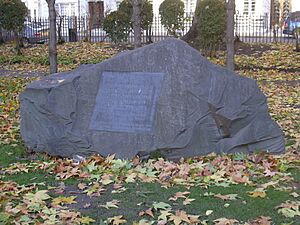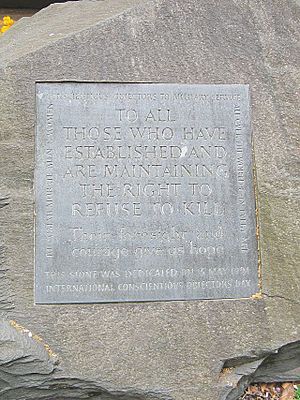Conscientious Objectors Commemorative Stone facts for kids
The Conscientious Objectors' Commemorative Stone is a special monument. It is located in Tavistock Square in London, England. This stone remembers people who chose not to fight in wars. They are called conscientious objectors. The stone honors them from all times and places. It was unveiled in 1994.
Contents
What is the Conscientious Objectors' Stone?
This large stone was put up to remember conscientious objectors. These are people who refuse to fight in wars. The Peace Pledge Union (PPU) helped organize its creation. Sir Michael Tippett unveiled the stone. He was the PPU's president. He was also a conscientious objector himself. The unveiling happened on May 15, 1994. It took place in Tavistock Square.
How the Idea Started
The idea for this stone began in 1976. It was at the funeral of Joseph Brett. He was a conscientious objector. Joseph had been put in prison in 1916 for his beliefs. Bill McIlroy led the funeral. He was part of the National Secular Society. Bill said that one day, conscientious objectors should be remembered. He thought they should be honored like soldiers.
Making the Stone a Reality
Joseph Brett's niece, Edna Mathieson, liked this idea. She worked with the Inner London Education Authority. In 1981, a group called the Greater London Council (GLC) agreed to help. But the GLC was later closed down. So, the plan for the stone was put on hold.
Edna then asked Lambeth Council for help. They even started a competition for a sculpture. But Lambeth Council also faced money problems. They could not afford to pay for the monument.
Finally, Edna asked the Peace Pledge Union (PPU) for help. The PPU agreed to take on the project. They helped with the design and finding a place for the stone. They also helped raise the money needed.
Choosing the Stone
The PPU asked Camden Council for permission. They wanted to put the stone in Tavistock Square. On May 15, 1993, a public appeal was launched. This was on International Conscientious Objectors' Day. Sir Michael Tippett wrote a letter in The Guardian newspaper to ask for support.
At first, granite was considered for the stone. Granite is a very strong stone. This would symbolize the strength of those who refused to fight. But the PPU's adviser, Hugh Court, and sculptor, Paul Wehrle, found something else. They went to Cumbria and found a large piece of grey-green slate. It was about 400 million years old. They liked its natural shape and chose it instead.
The PPU decided what words would be carved on the stone. They added the phrase: "Their foresight and courage give us hope." A writer from Dublin helped with these words.
Annual Remembrance Event
In 1998, Edna Mathieson pushed for another part of Bill McIlroy's idea. She wanted an annual event to remember all conscientious objectors. A planning group was formed. A member named Jess Hodgkins suggested the group be called the Right to Refuse to Kill Group (RRK).
Since then, there has been an annual memorial event. It happens every year at noon on May 15. This day is known as International Conscientious Objectors' Day.
What the Stone Says
The stone has important words carved into it. These words help us remember why it was created.
Around the top edges, it says: "TO COMMEMORATE MEN & WOMEN CONSCIENTIOUS OBJECTORS TO MILITARY SERVICE ALL OVER THE WORLD & IN EVERY AGE"
In the middle, it reads: "TO ALL THOSE WHO HAVE ESTABLISHED AND ARE MAINTAINING THE RIGHT TO REFUSE TO KILL
Their foresight and courage give us hope"
Along the bottom edge, it states: "THIS STONE WAS DEDICATED ON 15 MAY 1994 INTERNATIONAL CONSCIENTIOUS OBJECTORS' DAY"
Other Peace Memorials Nearby
Tavistock Square has other important memorials too. These also promote peace.
- A statue of Mahatma Gandhi is in the square. It was made by Fredda Brilliant and put there in 1968. Gandhi was famous for his peaceful protests.
- A cherry tree was planted in 1967. It remembers the victims of the nuclear bombing of Hiroshima and Nagasaki.
Because of these three memorials, some people call Tavistock Square a "peace park" or "peace garden." Annual ceremonies are held at each of these memorials. This includes the International Conscientious Objectors Day on May 15.



